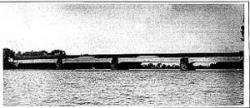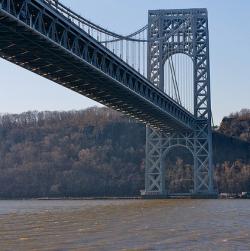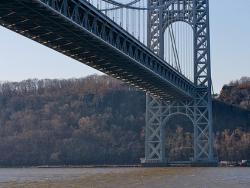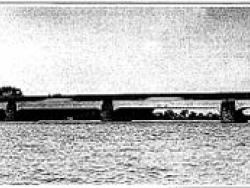The confluence of the Mohawk and Hudson rivers was the site of distinct advances in transportation of the early 19th Century. The Erie Canal in 1825 and the Mohawk and Hudson Railroad in 1831 were both of national significance.
Hudson River

The Union Bridge was built in 1804 by Theodore Burr and was the first to cross the lower section of the Hudson River connecting Waterford and Lansingburg, New York. The wooden bridge's key feature was the arch that started below the deck at the abutments and ran near the top of the top chord at mid span. This was the first time in the United States that anyone had used an arch in combination with a truss in order to provide both stiffness and strength. Burr later patented his truss/arch pattern in 1806 and 1817.

"An essential part of the human experience is to create an aesthetic atmosphere."
The George Washington Bridge represented a departure in suspension bridge design. Chief Engineer O.H. Ammann developed a system of stiffening trusses that offered greater flexibility and saved the project nearly $10 million. Initially, just six of the upper eight lanes were paved, but Ammann designed the bridge to easily accommodate a future lower level.
Swiss-born O.H. Ammann (1879-1965) was Chief Engineer for the Port Authority of New York and New Jersey during the bridge's construction.

The 1.6-mile Holland Tunnel was the first underwater vehicular crossing of the Hudson River and the first tunnel specifically designed for automobiles and trucks. It dramatically reduced the time required to traverse the Hudson River, a trip previously possible only by ferry.
A major difficulty when tunneling beneath a river is to keep water and mud from inundating the workers and equipment in the tunnel. Builders of the Holland Tunnel used a shield that enveloped the work site as the excavation progressed; this also avoided obstruction of shipping traffic during construction.
Innovations

The 1.6-mile Holland Tunnel was the first underwater vehicular crossing of the Hudson River and the first tunnel specifically designed for automobiles and trucks. It dramatically reduced the time required to traverse the Hudson River, a trip previously possible only by ferry.
A major…
Read More
"An essential part of the human experience is to create an aesthetic atmosphere."
The George Washington Bridge represented a departure in suspension bridge design. Chief Engineer O.H. Ammann developed a system of stiffening trusses that offered greater flexibility and saved the project…
Read More
The Union Bridge was built in 1804 by Theodore Burr and was the first to cross the lower section of the Hudson River connecting Waterford and Lansingburg, New York. The wooden bridge's key feature was the arch that started below the deck at the abutments and ran near the top of the top chord at…
Read MoreThe confluence of the Mohawk and Hudson rivers was the site of distinct advances in transportation of the early 19th Century. The Erie Canal in 1825 and the Mohawk and Hudson Railroad in 1831 were both of national significance.
The Erie Canal started at a boat basin in Albany. It…


